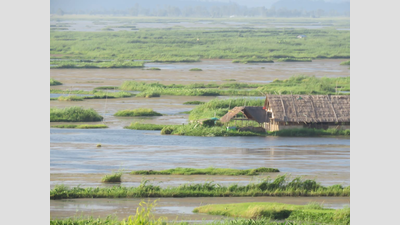ARTICLE AD BOX

The Loktak Lake in Manipur
Guwahati: A recent study by Nagaland University raised an alarm for Loktak Lake, a renowned freshwater ecosystem in Manipur and a designated Ramsar site.The research highlights how changes in land use, particularly through agriculture, settlements, and shifting cultivation, are degrading the water quality of rivers that feed into the lake.
This deterioration poses a threat to the lake’s rich biodiversity and the livelihoods of local communities, researchers said.Loktak Lake is a vital habitat, home to 132 plant species and 428 animal species, and supports activities such as hydropower, fisheries, transport and tourism. However, it has been listed on the Montreux Record, a global warning list for wetlands facing severe ecological damage. Concerns are mounting over reduced fish populations, rising pollution, and increased sedimentation.The study involved field sampling across nine rivers that flow into the lake. Using detailed Land Use Land Cover (LULC) maps, assistant professor of environmental science department at Nagaland University, Eliza Khwairakpam, analysed various land activities and their impact on water quality indicators such as dissolved oxygen, biological oxygen demand, and temperature.“Our study confirms that land use decisions across villages and forest landscapes upstream are directly impacting water quality downstream.
This makes community-based land management and stricter control of agricultural runoff and waste discharge crucial for restoring Loktak Lake,” said Eliza, adding that land management is not just an environmental concern but a livelihood protection strategy for the people of Manipur.
“Catchment-wide land regulation, sustainable agriculture practices, and controlled Jhum cycles will be vital for protecting India’s only floating national park and the endangered Sangai deer habitat within the lake,” she added.During the study, Nambul river was identified as the most polluted, with low oxygen levels and high organic contamination, directly linked to 47% agricultural land and 11% settlement areas in its sub-catchment. The Khuga river showed the second poorest water quality, despite having higher forest cover. Researchers attribute this to extensive Jhum (shifting) cultivation, which was recorded at 42% in the region.
In contrast, rivers such as Iril and Thoubal, which flowed through greater forest-dominated landscapes, displayed better water quality, highlighting the protective role of natural vegetation.The study, published in the International Journal of Environment and Pollution, was supported by the forest department, govt of Manipur, and the Manipur Pollution Control Board, with contributions from Nagaland University and IIT Delhi.Prof Jagadish K Patnaik, vice-chancellor of Nagaland University, said the study highlights the urgent environmental challenges from agricultural run-off, human settlements, and shifting cultivation affecting river water quality. Nagaland University is committed to research-driven environmental stewardship to inform policy, promote sustainable livelihoods, and protect natural ecosystems.

 2 hours ago
3
2 hours ago
3









 English (US) ·
English (US) ·